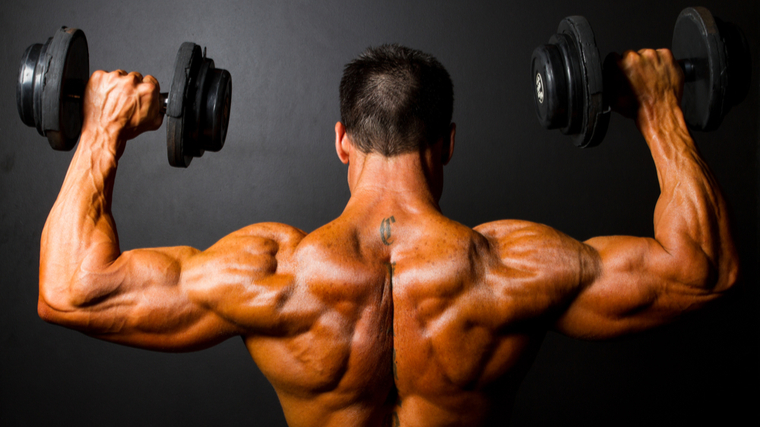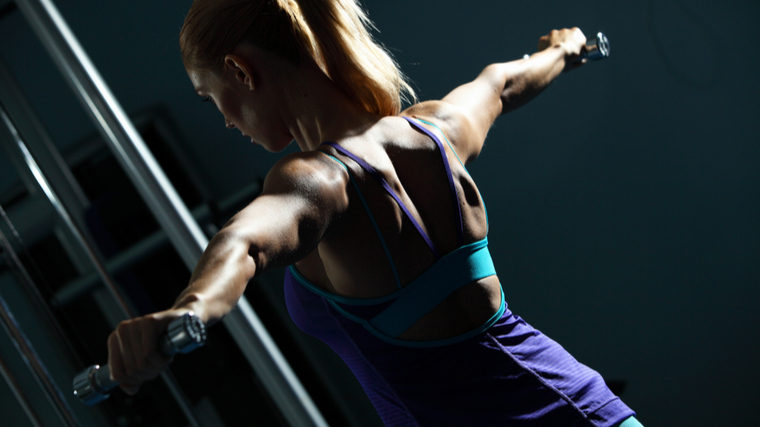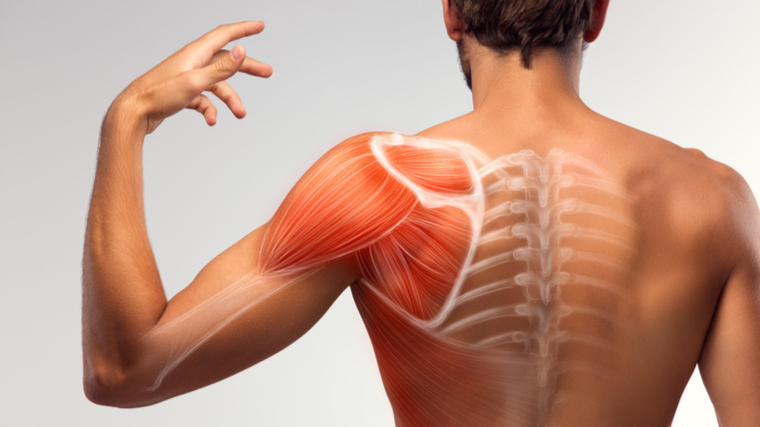If you could only train one part of your upper body, what would you pick? There’s a case to be made for your arms, chest, lats, or even your traps as the most important element of a well-developed physique.
But nothing quite ties things together like a pair of capped, three-dimensional delts. Big shoulders can do everything from helping you press heavier on the bench to stabilizing your first handstand. Above all, they contribute to your torso taper and give you more physical gravitas both in the weight room and on the bodybuilding stage.

You can’t build your shoulders with the same battle plan you apply to your legs or back, though. The shoulder is a smaller muscle group and takes both precision and finesse to develop.
This is the best bodybuilding shoulder workout on the block — cut three ways so you can make gains no matter where you are on your fitness journey.
Best Bodybuilding Shoulder Workouts
- Bodybuilding Shoulder Workout — Beginner
- Bodybuilding Shoulder Workout — Intermediate
- Bodybuilding Shoulder Workout — Advanced
The Best Bodybuilding Shoulder Workout for Beginners
As a beginner in the gym, you’ve lucked out. Since your physique is ripe for gains, you might find that your shoulders grow “by accident” if you properly train your chest and back. The muscles of your shoulder assist in many other large movement patterns by default.
To that end, a couple of sets of lateral raises added into your normal workout may be enough early on. If you want to specialize in shoulder hypertrophy specifically, you don’t need to get too crazy just yet.
The Workout
If you’re performing some of the staple foundational movements like the bench press, push-up, or overhead press, your shoulders are already getting plenty of love. Most “push” exercises, though, work the front of your delts quite well but leave something to be desired for the side and rear sections.
- Dumbbell Overhead Press: 3×6
- Dumbbell Lateral Raise: 3×12
- Resistance Band Face Pull: 3×15
How to Progress
One exercise for each of your shoulder’s three heads is more than enough early on. You’ll find it much easier to add weight to your presses while increasing reps on the lateral raise than if you tried to do the opposite.
Work on using heavier dumbbells each week for your overhead presses as long as you maintain proper form — for the lateral raises and face pulls, slowly ratchet up the number of reps you perform as long as your technique is equally as consistent.
The Best Bodybuilding Shoulder Workout for Intermediates
With a few years of proper training under your lifting belt, it’s time to get personal with your shoulders. As an intermediate bodybuilder, you still have plenty of space to climb on your physique journey — it just might require a bit of dedicated attention to the details.

Basic barbell exercises are great, but they probably aren’t going to get you all the way to your end goal.
The Workout
You probably have little trouble stimulating your front delts properly. After all, they have an important supportive job during your chest workouts. Regardless, there’s no harm in adding some proper pressing into the mix.
As for the sides and back of your shoulders, effective isolation is the name of the game.
- Arnold Press: 3×6,8,12-15 as a pyramid
- Dumbbell Hex Press: 3×10-12
- Cable Lateral Raise: 4×12-15
- Dumbbell Y-Raise: 2×15
- Resistance Band Pull-Apart: 2 sets to failure
How to Progress
When progressive overload begins to lose some steam, you need to look to alternative methods of increasing your workout intensity. Variable rep ranges give you some flexibility about when to push yourself — on good days, crank out a few extra reps where possible.
If you’re feeling sluggish in the gym, take it easy on the heavier lifting and apply more effort to the lighter stuff instead. Capping off the session with some resistance band work lets you take your rear delts to absolute failure in a low-risk environment.
The Best Bodybuilding Shoulder Workout for Advanced Lifters
If you want to be known for your shoulders on stage, a couple of lazy sets of lateral raises at the end of a long workout won’t cut it. Even as an advanced bodybuilder with heaps of experience, it can be all too tempting to relegate your smaller exercises to the back half of your session — and half-ass them to boot.
The Workout
A practiced and proficient physique athlete can get away with things that would be too intense for gym newbies. Namely, making active use of your rest periods to cram in extra volume. After many years in the gym, hypertrophy doesn’t come easily.
This is especially true for your delts, so you’ll need to get down and dirty with your workouts.
- Resistance Band Pull-Apart: 3×20 as a warm-up
- Cable Lateral Raise: 2×12-15
- Seated Neutral-Grip Dumbbell Overhead Press: 4×15,12,10,8 as a pyramid
- Front Raise: 3×12-15
- Cambered Bar Upright Row: 3×12-15
- Face Pull: 2×20
- Cable Rear Flye: 2×20
Note: Perform one set of 10-15 dumbbell lateral raises with a light weight during the downtime between each set of every listed exercise.
How to Progress
This workout takes volume and density to the extreme. Your delts need a lot of stimulation to grow, but no one wants to slog through a three-hour workout. Cable lateral raises while you’re fresh, followed by intermittent sets of the same movement pattern between other exercises, will absolutely scorch your shoulders before you even know it.
The other movements target all three heads of your shoulder with some extra love to your rear delts to keep your rotator cuff in fighting shape. Focus on strong contractions, adding weight when possible, and maintaining active effort from start to finish.
Anatomy of the Shoulder
Shoulder structure is a three-pronged situation. Your shoulder capsule is the most mobile and free-moving joint in your body, which means that you should probably have a working understanding of its design so you can train it effectively.
Anterior Deltoid
The front compartment of your deltoid is your sidekick muscle on almost every variation of horizontal or vertical presses. Any time you flex your arm, or raise it up in front of your body, you’re involving your front delt.
Medial Deltoid
The middle section of your shoulder is perhaps the most difficult muscle to stimulate without making use of specialized isolation moves. Your medial deltoid has the distinct function of shoulder abduction — raising your arm out to the side.
Variations of the lateral raise movement are therefore the only practical way to train your side delts for hypertrophy.
Posterior Deltoid
Your rear delt is a small muscle on the back of your shoulder. It is notoriously difficult to isolate and is one of the most essential parts of healthy shoulder mechanics when you train.

Strong, well-developed rear delts not only contribute to that three-dimensional cannonball look, but also help you lift heavy on the bench press as well. Sweeping your arm out to the side — think the opposite of a chest flye — is predominantly achieved by your posterior deltoid.
Trapezius
Your traps aren’t part of your shoulder in a direct sense. However, they do assist with carrying out many of the same biomechanical functions that the shoulder performs. In particular, you may find it difficult to isolate your middle deltoid and turn your lateral raises into too much of a shrug.
Muscle groups working together synergistically is fantastic for lifting heavy weights, but it’s worth being mindful of for bodybuilding. You don’t want your traps to overtake your delts during a shoulder workout.
Shoulder Training Tips for Bodybuilders
A good leg workout is different from an effective chest session — and your shoulders are more unique still. While there are some principles that do carry over between muscle groups, you should also be aware of the following tips and tricks for making the most of your delt days.
Prep for Your Presses
Heavy pressing takes a toll. Big overhead lifts are awesome for developing beefy shoulders and triceps, but there’s an opportunity cost. Even as a bodybuilder, make sure you take time to properly warm-up your shoulders before hitting up heavy presses.
Light upper back exercises and at least one or two warm-up sets of the movement you’re working with is a great way to get your heart rate up and ensure you can train heavy while limiting risk of injury.
Use Machines & Cables
There are a multitude of good exercises for shoulder growth. While this is advantageous for the creative-minded programming enthusiast, many free-weight raises that isolate a certain part of the deltoid suffer from an inconsistent resistance curve.
The dumbbell lateral raise is very easy in the first half and rapidly becomes unreasonably difficult at the top. If you have sloppy form or neglect the upper portion of the rage of motion, you’re not adequately fatiguing the tissue.
Both cables and machines have consistent resistance from start to finish, making them incredibly effective for shoulder training in particular.
Change the Angle
Everyone’s shoulder joint is different. Anatomy is the playbook whose rules you must obey in the gym. In practical terms, this means having a willingness to tweak your form as needed so that the movement works for your shoulders.
Don’t be afraid to alter the angle you raise or press your arm from. If the “standard” technique of a movement brings you zero connection with the muscle you’re working, what’s the point? The shoulders in particular are highly susceptible to individual differences, so make sure you’ve got things lined up properly.
Reps Over Weight
While you’re certainly able to push big weights overhead, you’re going to find it hard to progressively overload your lateral raises or rear flyes by using heavier resistance. The best way to take your shoulders to the limit is through cranking up your time under tension.
Work Shoulders First
This may not be relevant if you’re able to maintain high energy in your workout from start to finish. Regardless, if shoulder growth is a priority for you, shoulder training needs to come first chronologically as well as philosophically.
Putting your delt training at the front of your workout means you’re more likely to apply higher levels of effort and have better concentration, period.
It may feel a bit weird, especially if you’re used to starting your sessions with something like squats or the bench press, but you’ll notice much more engagement from your delts — especially if you typically work them at the end of the day.
Burn It Down
Training to failure is fickle. While it is wise to push your limits from time to time, not every muscle group or movement pattern is safe to regularly push to failure, especially if you don’t know how to properly exit a lift gone wrong.
Fortunately, aside from certain presses, delt training is a low-risk environment for high-intensity training. The physical nature of exercises like the lateral raise make them safe to go a little crazy with. The worst that can happen is that you’ll be so sore that you’re unable to raise your arm the next day.
Delt Day, Best Day
Big shoulders help bring your whole physique up. You don’t need to be so broad that you can’t fit through doorways — though that is an impressive aspiration if you want to take it there — but you should probably be prioritizing round, capped delts to some degree.
It’s easy to make the small movements feel like an afterthought. Can you build impressive shoulders by accident on chest day? Heck no, but it’s a good place to start as a beginner. But with the right movements in your pocket and heaps of dedication, Death Star-esque delts aren’t out of reach.
Featured Image: michaeljung / Shutterstock